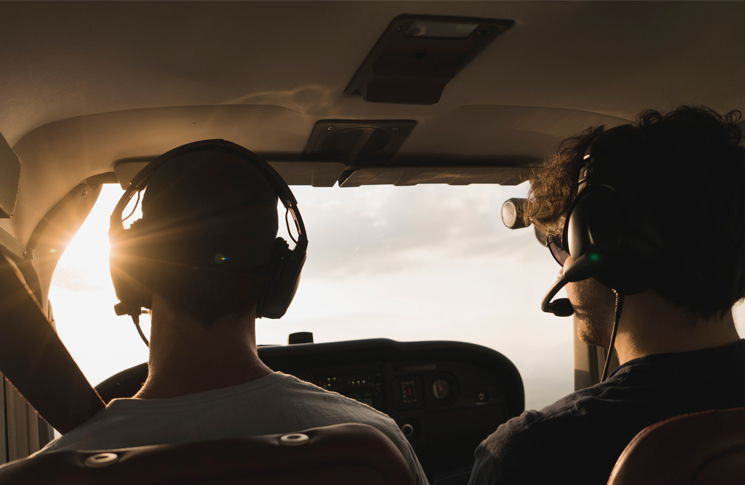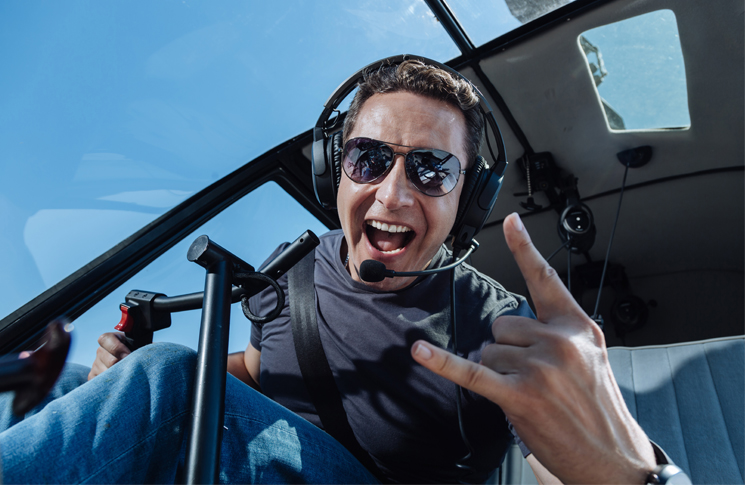by Nicholas Stobie
It’s a common trait amongst pilots. That beaming look on our faces when anyone starts talking about aircraft. It might fade a little bit with time, but it’s something that seems to stick with pilots young and old. Without this enthusiasm, few of us would have taken the very expensive plunge into aviation to begin with. Few of us would have accepted a poorly paid role in remote Australia to fly around a beat-up old Cessna 206. Few of us would have abandoned well-paid careers to pursue a dream. Without denying the devotion that people do hold towards other careers, there’s certainly something unique about the passion that you seem to find in aviation.
I’m still quite young and early in my career, which almost by default makes me enthusiastic. I like to think I’m even a little more enthusiastic than the default setting, and this has certainly opened doors for me. Small businesses live on the enthusiasm of their employees, and an upbeat attitude can be all it takes to show a potential employer that you’re the right person for the job.
Enthusiasm, however, is a subtly two-edged sword. If you open a human factors textbook, enthusiasm feeds so many of the phenomena that adorn the pages. There’s a quote out there from former US President William Howard Taft : ‘Enthusiasm for a cause sometimes warps judgement.’
Reflecting on my career so far, whilst enthusiasm has opened many doors for me, it has also been the boot in my backside pushing me through those doors before having a chance to properly peek inside. Good training, luck and mentoring has kept me from losing a grip on the doorframe, but the abyss of bad outcomes behind some doors has unfortunately claimed more than a handful of pilots.

Traps for young players
My first high-performance twin endorsement was a Piper Navajo, which belonged to a company I had been toiling in the hangar for about a year or so while doing other flying. The first thing my instructor handed me was a BASI (now ATSB) report into the crash of VH-WGI. At the time I thought I was being handed the report to show how Piper Navajos/Chieftains can bite in terms of performance and handling. However, I was wrong, and in hindsight, it was squarely intended to curb my enthusiasm.
WGI was a Piper Chieftain on a private flight from Moorabbin to Launceston in 1993, carrying nine footballers heading down to Tasmania for a weekend away. The aircraft was one of three aircraft organised by the pilot of WGI who was in command. With no prior experience on Chieftains and limited experience at night or under the IFR, the pilot underwent a type endorsement in the week leading up to the trip. Although initially planning to arrive before last light, delays in departure pushed their arrival time into the night. The weather deteriorated as WGI crossed Bass Strait, and low cloud surrounded the aerodrome. Not current on the ILS, the pilot elected to conduct a riskier DME arrival followed by a circling approach. Turning base, he became disorientated (possibly entering cloud) and collided with the ground just next to the beginning of the approach lighting tree. Six of the ten occupants perished in the ensuing fire.
Contained in the report are a litany of factors contributing to the accident, including a short type endorsement (1.8 hours), the pilot’s limited experience, not being IFR current, and heavily intoxicated passengers. Not contained in the report is the role enthusiasm might have played in the lead up to the crash.
The pilot was 23 at the time, the same age I was when I did my endorsement.
Not just for the young
On the topic of age, enthusiasm can strike even those among us with slivers of grey hair. Mid-life flyers are quite often the lifeblood of local aeroclubs, and in many regards, this demographic is equally exposed to the risks of enthusiasm. Although perhaps tempered compared to their younger peers, pilots entering aviation in middle age are often much better resourced financially. This allows them to progress quickly and take on challenges such as aircraft ownership, as an inexperienced 39-year-old pilot from Queensland did in September 2008.
Having held a Private Pilot Licence (PPL) since May of that year, and with 112 hours flying experience, he decided to purchase a Cessna 206, VH-JDQ, from Bankstown. On a typical September Sunday morning in Sydney, marred by wind and rain, the pilot purchased the aircraft and underwent a check flight with the previous owner. The pilot had never flown a Cessna 206 prior to this check flight. Included was some instruction on how to use the panel mounted GPS. The pilot’s intention was to fly back to Archerfield with his new purchase, following a short refuelling stop in Scone to pay a quick visit to some friends. Joining him for the journey were his partner and her young son.
Discussing the weather with the previous owner, the recommendation to track coastal was made, citing a frontal system moving across NSW that would likely impact his preferred route via Scone. No evidence was found that the pilot had accessed NAIPS to obtain the required weather briefings, however the forecast detailed isolated showers and low broken cloud in the vicinity of Scone. A SIGMET for severe turbulence below 10,000 feet was also current.
The pilot filled JDQ to full tanks and departed Bankstown and flew almost continuously through rain to Scone. Meeting with his friends in Scone, the offer was made for the trio to overnight in Scone prior to continuing to Archerfield, however the pilot declined this offer. At approximately 10:00 am, JDQ set-off after refuelling for the next sector. When the aircraft failed to arrive in Archerfield later in the day, it was reported to AMSA as missing by family who were awaiting its arrival. No flight plan had been filed, nor SARTIME. The subsequent search found that the aircraft had impacted a 3800-foot ridge in rugged terrain, approximately 30 nm north-north-east of Scone, tragically killing the pilot and his two passengers.
Following an investigation by the ATSB, it was found that JDQ had continued VFR into IMC conditions, and during a turn to exit these conditions struck terrain. Both the forecast and actual weather conditions were unsuitable for VFR flight. The aircraft also had outstanding maintenance requirements that had expired two weeks prior to the flight, none of which directly affected the accident flight. Again, enthusiasm was not mentioned in the report, but it’s hard to imagine our pilot as being anything but enthusiastic about his new purchase.
Drawing the parallels
Reading through both reports, I can’t help but imagine myself in the same situations. It’s a dangerous mix—enthusiasm and inexperience.
The obvious parallel between these accidents is spatial disorientation, but the real parallel that stuck me was the enthusiastic motivations of both pilots. Both were presented with situations that on their own might have elicited a no-go. WGI’s pilot might have diverted or cancelled the flight if it were not for the enthusiasm of a trip organised around Launceston and a planeload of intoxicated footballers. JDQ’s pilot might have stayed on the ground if the flight was just a joy flight on his own. But when a decision is go or no-go, do or do-not, press on or turn back, enthusiasm for the cause we find ourselves behind so easily provides a confirmation bias for the go decision. Investment in this decision leads us to assume that all will be ok.
In an unfortunate correlation, enthusiasm seems to wane with experience, and so it’s the inexperienced that all too often are caught off guard when enthusiasm strikes hardest. It’s a difficult thing to bring into check—enthusiasm. You can’t simply tell an eager pilot not to be enthusiastic, something I’m sure my instructor was aware of when handing me the report on WGI. Doing so risks the message being lost in the defensive response that might be elicited. A friend of JDQ’s pilot was reported to have told a newspaper ‘I used to tell [him]: “Be careful”. He only got his open [pilot’s] licence four to six months ago.’ The reality is that appreciation of one’s own enthusiasm is something that I believe can only really come from introspection. I do acknowledge the paradox of writing that last sentence of advice.
Eventually, time solves the enthusiasm issue among most of us. First, we get less enthusiastic. Many things do still excite me as a pilot, but after only a few years and nearly 2000 hours in, it’s becoming more of a slow burn. I still love flying, particularly privately, but it has never been quite as exciting as during those first couple of hundred hours. I find it very much easier to divest myself of the outcome of a go/no-go decision. Deferring a flight and grabbing brunch is an equally enjoyable way to spend a Sunday morning if the weather isn’t conducive to flight, even if it means a disappointed passenger or two.
But more importantly, time equips us with experience. Experience builds not only the quality but also the strength of our judgement, overpowering any misguided enthusiasm. Which leads to the obvious question—how do you build that experience? Both these lessons came from the mistakes of others, something made possible by the relatively strong reporting culture in Australian aviation. The ATSB makes investigation reports publicly available on release, and there are some very sobering reads on their website. I can’t quite put my finger on whether, in reading these reports, one increases their experience or diminishes their enthusiasm. It’s probably a mix of both.
At the time of writing, the ATSB database has 6893 records listed, or in a more appreciable unit—several lifetimes of experience. We are so willing to spend obscene amounts on money on developing our experience through flight training, and yet we can overlook these free lessons on offer. Often these reports detail incidents that arise not from handling or technical issues, but from decision making, and these are sometimes the best lessons for bringing enthusiasm back down to earth. Go digging into accidents that have happened on your aircraft type, at your local aerodrome or to those with similar experience to yourself. Take those lessons with you to your next flying lesson or private flight. You’ll not only avoid the mistakes of those before you, but you’ll metaphorically ground yourself in the process. Flight Safety Australia’s close calls are also a great way to share stories and learn from the experience of others.
Enthusiasm is a natural and very positive thing for pilots to have. It drives us. The industry would not exist today without it. But enthusiasm needs to be kept in check, and ultimately what I’m advocating for is a healthy scepticism of one’s own enthusiasm. It’s so easy for enthusiasm to take hold and push you astray. Listen out not only for that little voice in your head telling you something’s wrong but also for the chorus of enthusiasm drowning that voice out. Eliminating enthusiasm is both impossible and undesirable. Nonetheless, acknowledging it as an internal threat is the first step toward putting enthusiasm at an arm’s length from your decision-making process.



Comments are closed.